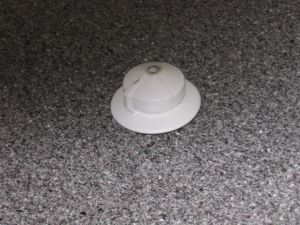| Manufacturer: | Scratch |
Brief:
This is a MicroMaxx saucer made from scrap plastic parts. It's a great backyard flier. IT is short for
Intra-Terrestrial, a play on ET.


Construction:
For the saucer-shaped part, most any roughly conical plastic parts will do. I used 2 cuttings from kits: the
discarded large end of the tail cone from Space Ship One (the large disk) and the discarded small end of the tail cone
from the Bullpup (the thicker cone). Your results may vary. I used a 1.5" length of a BiC pen for the motor tube
and a 1/4" slotted piece of pen for the engine block. A bit of an expended MicroMaxx motor would also work. All of
this should be free and available from your local friendly scrap drawer, parts bin, or trash can.
This is almost impossibly easy to build. I drilled ~5/16" holes in the center of the two plastic pieces for the motor tube. I glued the two together and glued the motor tube in so its top was flush with the top of the cone. I glued the engine block in so 1/4" of the 26mm long motor would stick out the back end. Finally, I drilled a 5/32" hole through both plastic parts about 3/8" off the centerline. This serves as the launch lug. That's all there is to assembly.
Flight and Recovery:
All three flights were on Quest MicroMaxx-II motors. I used the provided igniters and a standard Estes controller and
pad. Ignition reliability was poor because the igniters were hard to shove in enough to touch the propellant even after
I took them out of their little plastic casing. I actually recommend using Estes igniters pushed up it as much as
possible. The pyrogen tip will ignite the motor even if it's not in direct contact with the propellant. (MMX ignitors
are simply bare nichrome wire.) I put a clothespin up so there was about 6" of rod remaining. This tiny saucer
needs almost no rod at all to be stable. The next time I launch it, I will use a 12" long aluminum rod, which is
suitable for almost every MMX rocket.
All three flights were to about 40 to 60 feet depending on the wind. The rocket will drift with the wind both up and down, but in no case did it land more than 20 feet from the pad. You could easily fly it in a silo or a high-roofed gymnasium. I friction taped the motors to the bottom of the motor tube. This was more than adequate retention. Ejection occurs around apogee and the rocket slowly falls back by aerobrake recovery.
Summary:
PROs: Easy and cheap to build, barely needs any room to fly, low per-flight cost.
CON: Rather boring, in my opinion.
Sponsored Ads
 |
 |











